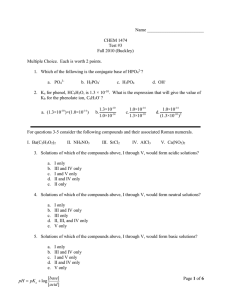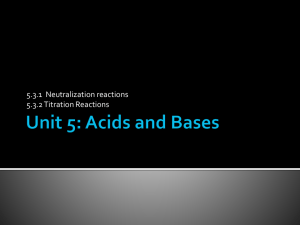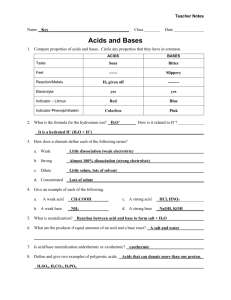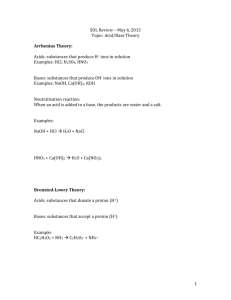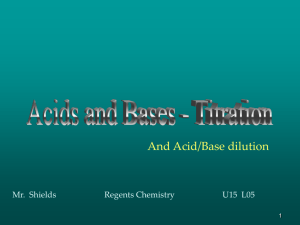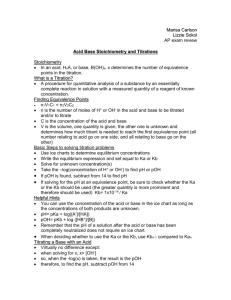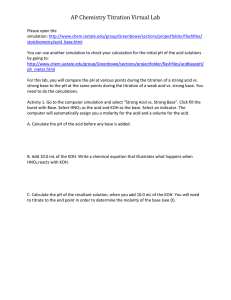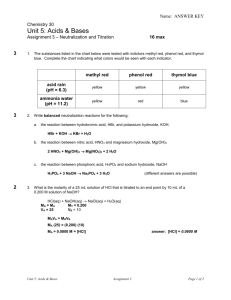TITRATIONS
advertisement
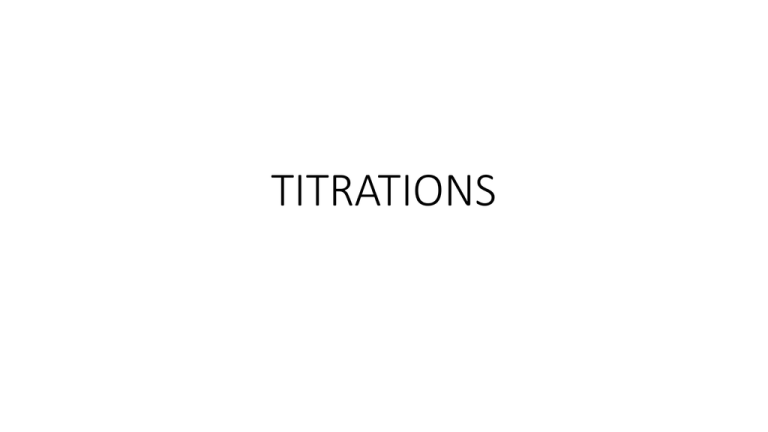
TITRATIONS Neutralization • Reaction between an acid and a base that produces water and a salt • (Type of reaction: Double displacement) Example: • H2SO4 (aq) + 2 KOH (aq) K2SO4 (aq) + 2 HOH (l) • Acid Base Salt Water • Remember: HOH = H2O Acid/base Indicators • An indicator is a substance that changes color when the pH changes. • Common indicators: • Litmus – changes from red to blue • pH Range: 5.0-8.0 • Phenolphthalein – changes from clear (acidic) to pink (basic) • pH Range: 8.2-10.0 • Bromothymol blue – yellow (acidic) to blue (basic) • pH range: 6.0-7.6 Video of the day: Cabbage pH Universal indicator Indicators Titration • Titration is controlled addition of a solution with a known concentration to a solution of unknown concentration. • Titrations enable us to find an unknown concentration by finding two things that are stoichiometrically equivalent Using a buret to do titrations Base or acid is slowly added until the solution changes color. The color change tells you that all of the base or acid has reacted so you can stop adding more. Equivalence point • Equivalence point: The point in a titration where the acid and base are stoichiometrically equivalent • There is no excess base or excess acid. All of the base and acid has reacted. • End point: The point in a titration when the color of the solution changes permanently. Titration curve An indicator is used to find the endpoint . You choose and indicator so that the endpoint is in the rapid rise region of the curve. Therefore the endpoint = equivalence point Finding an unknown Molarity or volume • Use (#H+) MaVa=MbVb (#OH-) • • • • • • H+ = Number of hydrogen ions (H+) from acid (see next slide for an example) Ma = molarity (M) of acid Va = volume of acid used in titration Mb = molarity (M) of base Vb = volume of base used in titration (#OH-) = Number of hydroxide (OH-) ions from base (see next slide for an example) Finding an unknown Molarity or volume • Use (#H+) MaVa=MbVb (#OH-) • Remember at equivalence point, moles of acid = moles of base • You must remember to use a mole ratio when the acid and base don’t react in a 1:1 mol ratio • Example: H3PO4 reacts with Ba(OH)2 • Mol H+ = 3 • Mol OH- = 2 • (3) MaVa=MbVb (2) Example – Per. 3 • When 10.0 mL of a 0.125 M solution of hydrochloric acid, HCl, is titrated with a 0.100 M solution of potassium hydroxide, KOH, what is the volume of base needed to neutralize the acid? • HCl + KOH KCl + HOH • (#H+) MaVa= MbVb (#OH-) • (1)(0.125 M)(10.0 mL) = (0.100 M) Vb (1) • Mb = 0.125 M x 10.0 mL = 12.5 mL KOH 0.100 M Example – Per. 4 • When 10.0 mL of a 0.125 M solution of hydrochloric acid, HCl, is titrated with12.5 mL of potassium hydroxide, KOH, what is the concentration of base needed to neutralize the acid? • HCl + KOH KCl + HOH • (#H+) MaVa= MbVb (#OH-) • (1)(0.125 M)(10.0 mL) = Mb (12.5 mL) (1) • Mb = 0.125 M x 10.0 mL = 0.1 M KOH 12.5 mL
